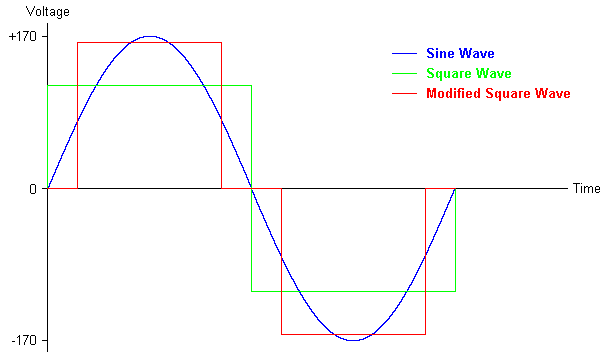[ The PC Guide | Systems and Components Reference Guide | Power | External Power | Uninterruptible Power Supplies | Uninterruptible Power Supply Functions and Features ]
Electrical Waveform Output
A quality consideration that can be important in some applications is the output waveform of the UPS. This refers to the shape of the alternating current signal produced by the UPS. The quality and cost of the inverter that is within the UPS is the primary determinant of the shape of the AC signal that is produced by most UPSes, especially ones on the lower end. The ideal situation is for the UPS to produce a clean output waveform that is close to what would be produced by the electrical utility, but this is not always the case.
There are three main waveform types produced by UPSes:
- Sine Wave: This is the best waveform, as it is the shape of an (ideal) AC electrical signal from the wall. The highest-quality UPSes produce a true sine wave output, which requires fairly expensive components in the inverter. This is especially important for online UPSes, since their loads are always running off the inverter. True sine wave UPSes are normally found only in higher-end models.
- Square Wave: The least desirable output waveform type, a square wave is sort of a "flattened-out" version of a sine wave. Instead of the voltage smoothly increasing from the negative maximum to the positive maximum and back again, it shifts suddenly from negative to positive, stays there for half a cycle, and then jumps to full negative and stays there for half a cycle, then repeats. Cheaper inverters are designed produce a square wave output primarily because the components required to do this are cheap. It wouldn't surprise you to learn that some equipment doesn't really like running on a square wave (it may be more surprising to learn that many types of equipment will run on it!) There are several reasons why square waves cause problems. For starters, the peak voltage of a square wave is substantially lower than the peak voltage of a sine wave, which causes issues with some types of equipment. In addition, while a sine wave has a single frequency in it--60 Hz in North America--a square wave contains many higher frequencies as well, called harmonics, which can cause buzzing or other problems with some equipment. Square wave output is found only in the cheapest equipment and should be avoided if possible.
- Modified Square Wave: This waveform is a compromise between the sine wave and the square wave. The positive and negative pulses of the square wave are thinned, separated and made taller, so the peak voltage is much closer to that of a sine wave, and the overall shape of the wave more closely resembles that of a sine wave. At the same time, the cost of the circuitry to produce a modified square wave output is much closer to the cost of a square wave's circuitry than that of a sine wave unit. (In fact, you can create a modified square wave by adding together two square waves that are shifted in phase slightly from each other.) Many fewer pieces of equipment have problems with modified square wave power than with straight square wave. Modified square wave output is used on many lower- to middle-range UPSes, and is also sometimes called "stepped approximation to a sine wave", "pulse-width modified square wave", or even "modified sine wave". The last term is marketing cutesy-speak, since the output form isn't really a sine wave, modified or otherwise.
|
Schematic representation of one cycle of a sine wave,
square wave, and modified square wave |
In practical terms, for a home PC UPS modified square wave output is fine. It will power a PC, monitor and similar equipment without any trouble. Of course, also remember that less expensive UPSes are normally running off line power anyway, and it is only when operating off the battery that the output waveform comes into play.
![]() Next: Automatic Shutdown
Next: Automatic Shutdown
| The PC Guide
(http://www.PCGuide.com) Site Version: 2.2.0 - Version Date: April 17, 2001 © Copyright 1997-2004 Charles M. Kozierok. All Rights Reserved. |
Not responsible for any loss resulting from the use of this site. Please read the Site Guide before using this material. |
